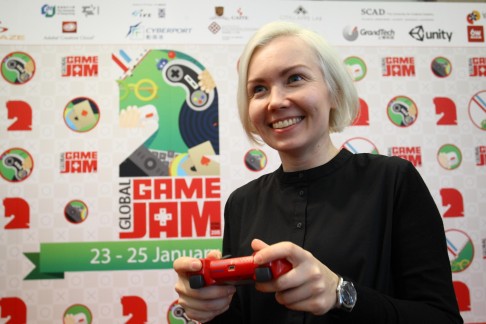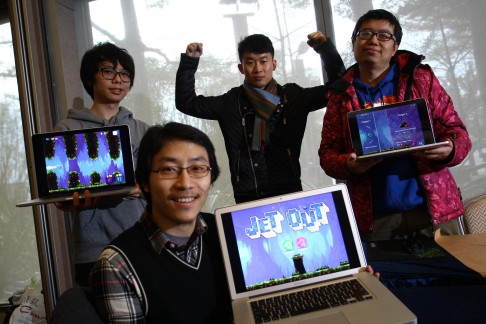
Could you design a new game in 48 hours? These Hongkongers did
When games enthusiasts and designers gathered at the Hong Kong leg of the Global Game Jam to experiment on new ideas, we found out the basics of creating fun
Think of it as a hackathon for games enthusiasts. Given just 48 hours, what engaging new form of play can your team come up with? What are the qualities of a game that will keep us absorbed for hours, even days? At the third Hong Kong Global Game Jam, one presentation that drew wryly appreciative laughter all round was a game called (Cantonese for paying off the mortgage). Players must perform a series of tasks to generate income that will go towards mortgage payments, and failing to meet payment targets will mean losing their properties.
It is the local iteration of Global Game Jam, a series of events introduced in 2009 by a group of developers. Open to all, the jams have grown steadily since then, attracting not only amateurs (artists, students and others) but also professional game designers and programmers to 518 events in 78 countries this year.
If the whole concept seems like yet more work for the pros who are already doing that in their day jobs, Hong Kong organiser Hanna Wirman says the appeal lies in its format, which pushes participants to think beyond traditional gaming norms.

"It creates an opportunity for professionals to do something they don't usually do and for students to actually complete a game," says Wirman, a research assistant professor of game development at Polytechnic University. "For professionals, they know about the market, what's in line with their existing products. But with Global Game Jam, they can try something that's not safe."
After all, the founders' idea was to bring people together to come up with innovative new ideas, and collaborate and experiment on different concepts and formats for games (including non-digital varieties). That's why participants are asked to create games around fuzzy themes such as "As long as we have each other, we will never run out of problems" (2009) and "Sound of a Heartbeat" (2013).
This year's theme, "What do we do now", yielded a typically freewheeling spectrum of possibilities. Many featured apocalypse-type scenarios involving multiple players who must work together to escape a monster, fend off an alien invasion, or convince different countries to help save the earth.
For a team from Zynga, the developers behind hit products such as FarmVille, Words with Friends and Zynga Poker, this set off ideas about survival and collaboration.
The result was a touch-screen game called Jet Out, where two players must work together to steer a rocket ship through a maze of stalagmites and stalactites.

"It gives me a chance to focus on something completely and there aren't many rules so you can imagine doing whatever you want. This feeling is hard to find in real life," says Blu Chen Xiaoqing, a user-experience designer at Zynga's Beijing office, who flew in for the jam staged at Cyberport last month.
His colleague, technical artist Jonathan Chu Ming-yan, concurs. "In Hong Kong there aren't many opportunities to create games and not have to worry about the results," he says.
The 24-year-old Hongkonger learned about the Global Game Jam while studying creative media at City University and has been hooked since he signed up for the city's first event. "I wanted to sneak out but had to present the game for my team. In the end we won a creative award, which was a big surprise," Chu laughs.
(This year's jam attracted 230 people, putting Hong Kong 14th on the list of sites with the most number of participants, while Giza in Egypt led with 1,703 people).
While some designers may focus on creating flashy effects, Wirman says what engages players is the mechanics of the game.
"A good game designer wants to create a game with learning experiences. There's a challenge and a goal, and the game should motivate the player to reach the goal incrementally through adding difficulties or challenges. You want the player to learn something new so that they grow in the end."
A strong narrative can also be a great motivator, allowing players to identify with characters in a story, but Wirman says the mechanics usually tip the balance although story and mechanics are interlinked.
With hit releases such as and , there's no need to know the back story to be able to play the game. However, "those stories are good for marketing purposes, to spin off things such as toys, cartoons, magazines, comics", she says.
"These games became popular because they tapped into the right moment just as games that were being played on a PC moved to smartphones But the goal for a good game designer is not to make the game addictive, but for the player to learn something."
You want the player to learn something new so that they grow in the end
At the Hong Kong jam, it is some of the simpler games that catch judges' interest. 2X15, in which players are like laboratory mice that must figure their way out of a dark room by taking into account objects they bump into and sounds they hear, took an award for Best Theme Fit.
Another judges' favourite is Ascension, an environmentally themed game, which won an award from sponsor iCare. Featuring a split screen, one side shows images of pollution (water, air or land), and if the player does nothing to clean up spilled oil barrels in the river, for example, then the screen on the right reveals how the environment will be affected.
Of course, motivation and how the game feels and looks to a player is just as important to the success of a game.
"We have to make things visually attractive and ensure the design of the tasks the players have to do flows well and is interesting," Chen says of designing user experience at Zynga.
"We even learn some psychology to [figure out] what players want.
"When it comes to men, they are keen on competition, they want to win, so we design games around this. The tasks don't have to be hard but they have to feel challenging.
"Women tend to like social media games such as and ; they like to collaborate to achieve things. The point of is to buy things such as livestock or trees, or help each other on their farms to do better in the game."

The huge variety of digital games means different looks are created to fit with the tone of the production, particularly the complex, collaborative games that have become the more popular formats: medieval fantasy quests, urban shoot-em-ups, and so on.
"[The look] depends on who you want to attract, what kind of designer you are and how polished you want it to look," Wirman says. "There are all kinds of games out there and if you are a gamer then you know all about the different sub-cultures in terms of how they look or the types of games. It's just like movies, where you can have mainstream films and alternative ones."
But as a teacher of game design, she encourages aspiring developers to think beyond scenarios such as conquering the world or war, and consider formats more about cooperation.
Beyond their entertainment value, Wirman adds, games can be used to help people in everyday life. For example, many companies use games to help train their staff, including simulations that take managers through problems that they might encounter in running a hotel. Reports also show that simulated game environments have been used to help US war veterans deal with post-traumatic stress.
Yet although digital games generally grab most attention (and dollars), it is a simple card-based game that has proved to be a winner at this year's game jam in Hong Kong. Called We Do, it's a guessing game in which one player picks cards featuring an item. He then makes sentences that describe the object without naming it, while others guess what it is.
We Do took the awards for best board game and best commercial potential categories; host Cyberport will produce a trailer that its creators can use to pitch to potential investors. ( , a game that emerged from the 2013 jam, was later released commercially as an app on Play Store.)
"It is interesting the We Do game got the highest vote among the participants," says IT veteran Richard Chui Wai-tao, who was a judge at the event. "That says a lot - it is the idea that counts. Some games are more polished and professional looking, but the gameplay is not interesting at all."

